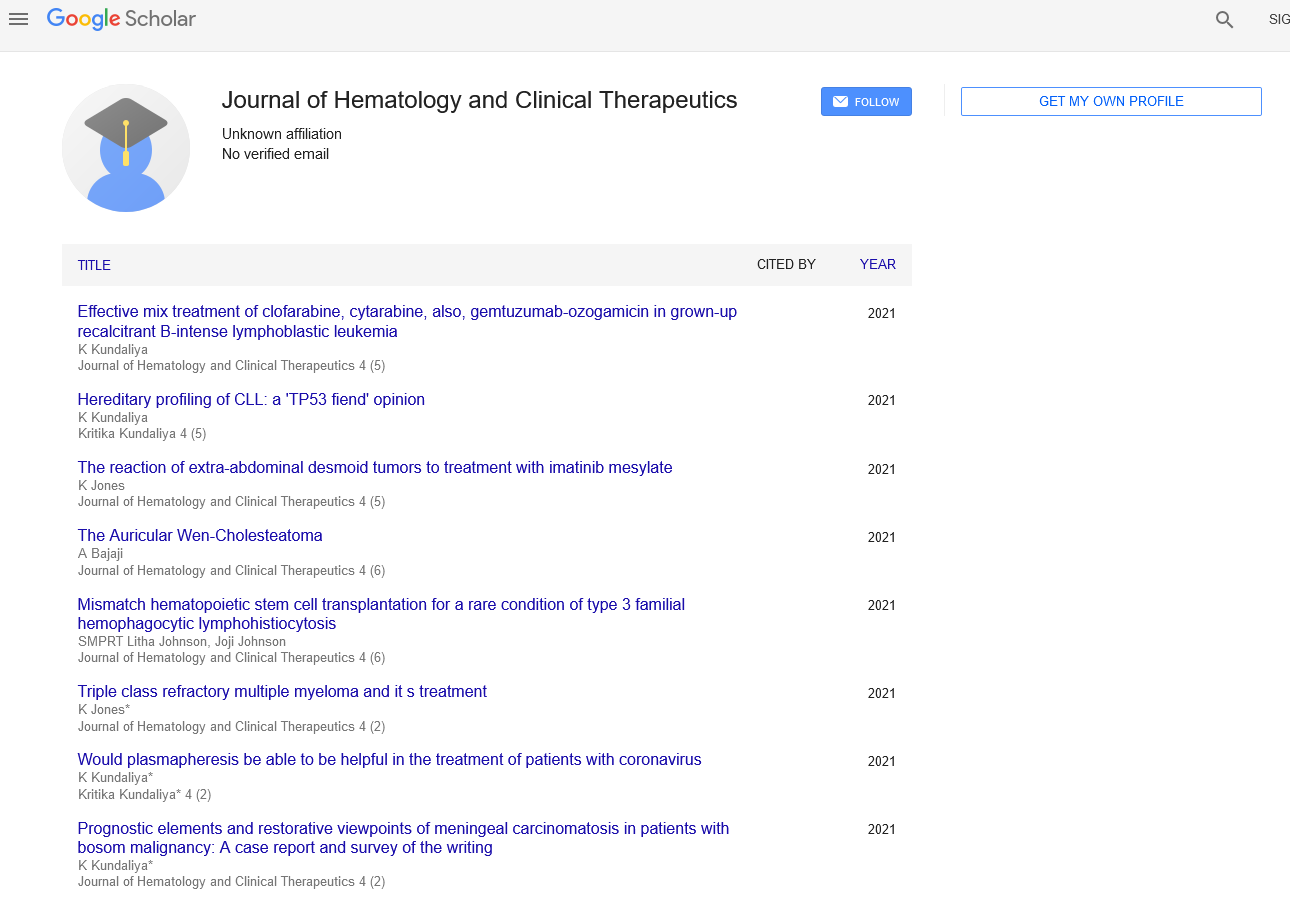Non-DOWN disorder youngsters with a myeloproliferative illness in the interest of the I-BFM AML study
Received: 08-Feb-2022, Manuscript No. PULJHCT-22-4632; Editor assigned: 11-Feb-2022, Pre QC No. PULJHCT-22-4632; Accepted Date: Feb 08, 2022; Reviewed: 15-Feb-2022 QC No. PULJHCT-22-4632; Revised: 20-Feb-2022, Manuscript No. PULJHCT-22-4632; Published: 21-Feb-2022
This open-access article is distributed under the terms of the Creative Commons Attribution Non-Commercial License (CC BY-NC) (http://creativecommons.org/licenses/by-nc/4.0/), which permits reuse, distribution and reproduction of the article, provided that the original work is properly cited and the reuse is restricted to noncommercial purposes. For commercial reuse, contact reprints@pulsus.com
Opinion
In youngsters with myeloid hyperproliferation, aside from harmless causes, Down condition (DS) related transient unusual myelopoiesis (TAM), intense myeloid leukemia (AML) and adolescent myelomonocytic leukemia (JMML) are considered. Besides TAM, once in a long while, non-DS related transient myeloproliferative illnesses happen, settling on clinical choices challenging. TAM, as indicated by World Health Organization (WHO) arrangement, just applies to kids with (mosaic) Down syndrome. previously, unique phrasing has been utilized in non-DS patients, like transient myeloproliferative sickness (TMD) and transient leukemia. Since differentiation from TAM is significant, and it is trying to decide if this infection will be transient, the agreement bunch presented the original term 'childish myeloproliferative illness' (IMD), to recognize it from TAM. Both TAM and IMD can as a rule be dealt with a 'watch and stand by' technique, while most fullblown AML or JMML cases require concentrated treatment. We gathered intriguing IMD cases from concentrate on bunches working together in the International BerlinFrankfurt-Münster AML Study Group (I-BFM AML SG). What's more, we surveyed the writing for neonatal instances of threatening myeloid hyperproliferation without DS. In light of this information, we grew, along with I-BFM AML SG and the European Working Group of Myelodysplastic disorders in Childhood (EWOG-MDS) individuals, by agreement, clinical proposals for the demonstrative methodology and current sufficient order of threatening myeloid hyperproliferation in earliest stages. This is implied directing clinicians in picking the right system, i.e., whether to ‘watch and stand by’ or begins exceptionally concentrated treatment in individual cases.
We halfway gathered nitty gritty data from information bases of IBFM AML SG colleagues to distinguish clinical and hereditary qualities of extra, not yet detailed cases with IMD. Kids more youthful than one year, analyzed somewhere in the range of 1990 and 2020, were incorporated. Moral endorsement and informed assent were gotten by each study bunch exclusively. Enlistment and information structures included clinical elements, hematological information, morphology and immunology, treatment, result and follow-up information. Accessible composed reports of cytogenetic discoveries were gathered and halfway inspected by Dr. A. Buijs (University Medical Center Utrecht) and Prof. Dr. S. Raimondi (St. Jude Children's Hospital, Memphis). We recognized 15 new instances of IMD with, sometimes, novel intermittent sub-atomic variations. No germline variations were recognized; nonetheless, normalized diagnostics didn't continuously incorporate germline testing. Thirteen patients had substantial trisomy 21 (T21) regardless of a GATA1 transformation, one patient had low mosaic physical trisomy 8 and a SETD2 change and one patient was not tried for substantial deviations. Outstandingly, among the 15 recently added cases, in four patients, assessment for GATA1 transformations was not performed.
The quest for accessible writing and case reports of non-DS transient leukemia was acted in the PubMed data set. Distributions recorded until 1 January 2021 was incorporated. Search terms included TMD, TAM and transient leukemia, utilized independently and joined with non-Down, non-Down disorder, and without Down condition. A cross-reference check was acted in key articles. We included 23 articles that depicted one or various patients that met our inquiry standards. Tragically, in these cases as well, routine testing of physical GATA1 and potential germline mosaic T21 was not played out all the time.
Innate/baby leukemia represents <1% of all adolescence leukemias. When the intriguing occasion happens in which a youngster is associated with myeloid leukemia, TAM or IMD, clinical direction can challenge. Here, agents of the I-BFM AML SG, along with JMML specialists from the EWOG MDS, give a clinically-appropriate agreement of indicative operations for youngsters more youthful than about a month and a half. This depends on writing and recently added cases from our worldwide overview, which might uphold clinical decision-production in individual cases. During two gatherings with driving individuals from both the I-BFM AML SG and EWOG MDS, significant writing was examined and master experience shared. We arrived at agreement on analytic procedures of children with myeloproliferation.
The differential finding of myeloproliferation in newborn children incorporates, aside from (intrinsic) contaminations and different stressors, JMML, AML, TAM and different sorts of IMD. More successive harmless fundamental circumstances ought to be genuinely considered prior to diagnosing a youngster with leukemia and starting serious treatment. A clinical history and actual assessment are essential to uncover introductory hints in regards to irresistible causes, different elements instigating pressure hematopoiesis and hereditary inclination (presence of dysmorphic and inborn irregularities). An actual assessment will likewise uncover hepatosplenomegaly, liquid aggregation as well as skin penetration. A complete blood count and morphological appraisal of the fringe blood smear did by an accomplished hematologist or morphologist in a specialist lab is compulsory, and fringe blood immunophenotyping is, as a base measure, advised.
Assuming a harmful condition is possible, the main test is to segregate an interesting transient case, where a 'watch and stand by' system might be supported, from a forceful leukemia subtype that might require serious treatment in a restricted stretch of time. Initial, a qualification among megakaryocytic and non-megakaryocytic leukemia is significant, in view of the morphology and immunophenotyping of the fringe blood impacts. Megakaryocytic hyperproliferation (French-American-British - FAB - order M7) can be perceived by reasonably basophilic agranular cytoplasm with blebs on morphology, joined with articulation of CD41, CD42 and additionally CD61 on stream cytometry.
In the event of megakaryocytic hyperproliferation, germline T21 and GATA1 changes might point towards TAM. Hat impacts can likewise introduce without megakaryocytic markers, FAB M0 (undifferentiated). In TAM, beginning stage and hepatosplenomegaly with monoclonal megakaryocytic hyperproliferation with T21 and a GATA1 transformation can be confirmed. The beginning of TAM lies in the fetal liver which is the reason, as a rule, fringe blood inspecting is adequate for a conclusion and a bone marrow cut is pointless. Without dangerous illness, a 'watch and stand by' strategy with close observing, including normal actual assessment and blood counts, is justified. Low-portion cytarabine treatment is informed in the event that concerning multiorgan disappointment, high WBC >100 x 109/l, hepatopathy (high bilirubin/transaminases, ascites), serious hepatosplenomegaly, hydrops fetalis, pleural or pericardial emanations, renal disappointment, or dispersed intravascular coagulation. This therapy doesn't forestall the improvement of MLDS (myeloid leukemia connected with down disorder), yet considerably diminishes mortality in suggestive patients. After reduction, follow-up is prompted like clockwork until the age of four
years, on account of a 20% opportunity of ML-DS advancement during that life span. MLDS requires more serious treatment, but this treatment has high achievement rates.





